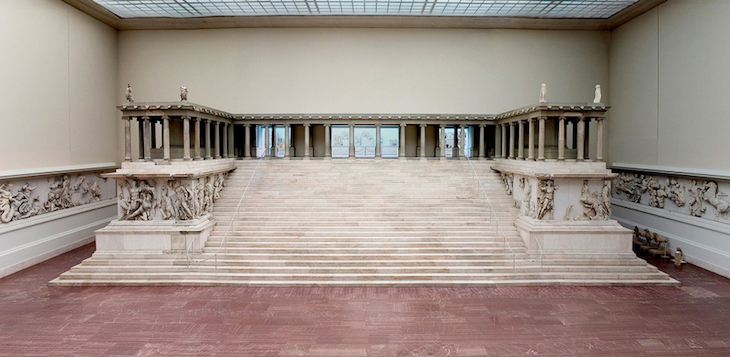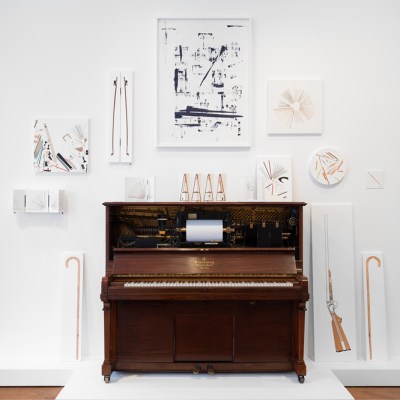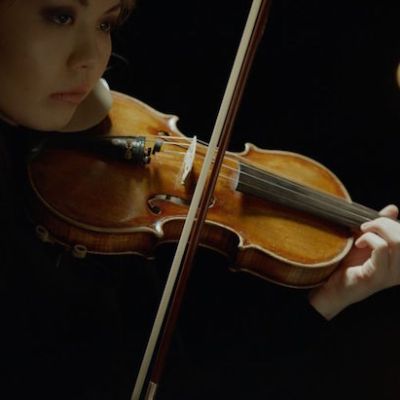The sound makes itself felt almost before it is heard: the low thud of a heartbeat building into the rumbling of a gathering storm, or an army approaching on foot, as you draw nearer to Turkish artist Cevdet Erek’s ‘Bergama Stereotip’ (2019–20), which half fills a room at Arter in Istanbul. Comprising a wooden structure, stacked cabinets, loudspeakers emitting 13 different channels of sound, and stairs ascending to a viewing platform, the piece – which Erek describes as a ‘sounding architecture’ – alludes to the Great Altar of Pergamon. Built around the 2nd century BC, the monument was encircled by an elaborate white-marble frieze depicting the epic battle between the Olympian gods and giants of ancient Greek mythology – the remains of which form the centrepiece of the Pergamonmuseum in Berlin.
Installation view of ‘Bergama Stereotip’ by Cevdet Erek, Arter, Istaanbul, 2019–20. Photo: flufoto

The looping deep bass notes of a davul, a traditional double-headed drum played by Erek, interspersed with a guttural human voice give ‘Bergama Stereotip’ a distinctly martial feel. But the artist says he wasn’t trying to create a sonic version of the Gigantomachy myth with his work. ‘There is a struggle there, but one between the sound patterns and the beats,’ Erek tells me. ‘It’s more about the story of the altar itself than the story on the frieze.’
Pergamon Altar, Pergamonmuseum, Berlin. Photo: Johannes Laurentius; © Staatliche Museen zu Berlin, Antikensammlung

That story begins in what is now western Turkey with the commissioning of the altar by Eumenes II, ruler of the kingdom of Pergamon, to commemorate his own military victories. Believed to have been an altar to Zeus, it was rediscovered in the late 1800s by German engineer and archaeologist Carl Humann and eventually ended up in Berlin. (It has been out of public view since 2016 due to ongoing renovations of the museum.) Along the way, it has been dismantled and reassembled multiple times; served as an inspiration for Nazi architects; had parts taken to the Soviet Union by the Red Army as spoils of the Second World War; and remains the subject of a repatriation campaign by the former mayor of Bergama, the modern Turkish town below the ruins of ancient Pergamon.
‘Cevdet’s work connects with history in a very political way, but it doesn’t restrict the discussion to, or take sides in, these ongoing debates about who took what, or for what purpose,’ says Selen Ansen, curator of the Arter exhibition. ‘Instead he creates a space to think about the idea of return, of what that might really mean, and about concepts like “origin” and “original” that we are used to using without really questioning them.’
Installation view of ‘Bergama Stereo’ by Cevdet Erek, Hamburger Bahnhof – Museum für Gegenwart – Berlin, 2019. Photo: Mathias Völzke.

The altar exhibited in the Pergamonmuseum is itself an interpretation of the structure that once sat on a windswept hilltop near the Aegean Sea, argues Ansen. ‘The frieze has always been connected to power, and it was rebuilt in Berlin with an eye for the spectacularity of it, with the idea that it would be gazed at by an audience,’ she continues. Erek has now added his own layers of interpretation, conducting extensive research into the Pergamon altar, which he has never seen in person, to create ‘Bergama Stereotip’ and a predecessor work, ‘Bergama Stereo’ (2019), exhibited first in Bochum, Germany, as part of the Ruhrtriennale 2018–20, and then at the Hamburger Bahnhof in Berlin.
A musician as well as an artist who originally trained as an architect, Erek says the idea of making spaces still deeply influences his work, which he sees as neither sculpture nor sound installation because of the interplay he creates between the auditory and spatial experience. ‘When I worked on these pieces, I continuously walked in the space, to all possible places where people could stand or sit,’ he says. ‘Since there are multiple sources of sound, you hear different things depending on your height, your location, but that repetitive beat also synchronises people in a way that’s outside the intellectual realm.’
The larger of the two works, ‘Bergama Stereo’ more directly mimics the symmetrical shape of the Pergamon altar, referring to the meaning of the Greek word stereós (solid) as well as the enveloping nature of its 34 channels of sound. With ‘Bergama Stereotip’ – its name a riff on the stereotype, a plate that can repeatedly print the same image without variation – Erek creates yet another interpretation rather than a copy. The colour of the work morphs from black, a nod to the historic coal mines of Bochum, to a deep red characteristic of some of the old wooden houses of Istanbul, the artist’s home. It becomes both more compact and more open, with empty spaces in both the physical structure and the soundscape allowing the audience to fill in the ‘missing’ parts.
Original site of the Great Pergamon Altar and its remains in Bergama, near Izmir, 2019.

These echoing and evolving iterations of Erek’s work mirror the historical journey of the altar, of which only the foundation – a set of steps leading nowhere – remains in its original location. The civilisation that built it is long gone, the ruins of its sacred temples converted into cultural artefacts for tourists or hauled away decades ago for use as construction materials for locals in nearby villages.
‘The work shows how history is not a fixed, frozen thing that comes from the past and moves into the present and the future in a very chronological way,’ Ansen says. ‘Instead it’s an ongoing shaping, an ongoing attempt to construct memory, working with the emptiness rather than against it.’
‘Bergama Stereotip’ is at Arter, Istanbul, until 3 January 2021.



